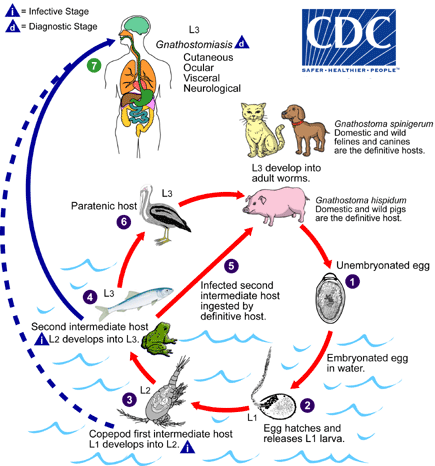Biology
Causal Agent:
The nematode (roundworm) Gnathostoma spinigerum and Gnathostoma hispidum, which infects vertebrate animals. Human gnathostomiasis is due to migrating immature worms.
Life Cycle:

In the natural definitive host (pigs, cats, dogs, wild animals) the adult worms reside in a tumor which they induce in the gastric wall. They deposit eggs that are unembryonated when passed in the feces  . Eggs become embryonated in water, and eggs release first-stage larvae
. Eggs become embryonated in water, and eggs release first-stage larvae  . If ingested by a small crustacean (Cyclops, first intermediate host), the first-stage larvae develop into second-stage larvae
. If ingested by a small crustacean (Cyclops, first intermediate host), the first-stage larvae develop into second-stage larvae  . Following ingestion of the Cyclops by a fish, frog, or snake (second intermediate host), the second-stage larvae migrate into the flesh and develop into third-stage larvae
. Following ingestion of the Cyclops by a fish, frog, or snake (second intermediate host), the second-stage larvae migrate into the flesh and develop into third-stage larvae  . When the second intermediate host is ingested by a definitive host, the third-stage larvae develop into adult parasites in the stomach wall
. When the second intermediate host is ingested by a definitive host, the third-stage larvae develop into adult parasites in the stomach wall  . Alternatively, the second intermediate host may be ingested by the paratenic host (animals such as birds, snakes, and frogs) in which the third-stage larvae do not develop further but remain infective to the next predator
. Alternatively, the second intermediate host may be ingested by the paratenic host (animals such as birds, snakes, and frogs) in which the third-stage larvae do not develop further but remain infective to the next predator  . Humans become infected by eating undercooked fish or poultry containing third-stage larvae, or reportedly by drinking water containing infective second-stage larvae in Cyclops
. Humans become infected by eating undercooked fish or poultry containing third-stage larvae, or reportedly by drinking water containing infective second-stage larvae in Cyclops  .
.
Life cycle image and information courtesy of DPDx.
- Page last reviewed: January 10, 2012
- Page last updated: January 10, 2012
- Content source:


 ShareCompartir
ShareCompartir